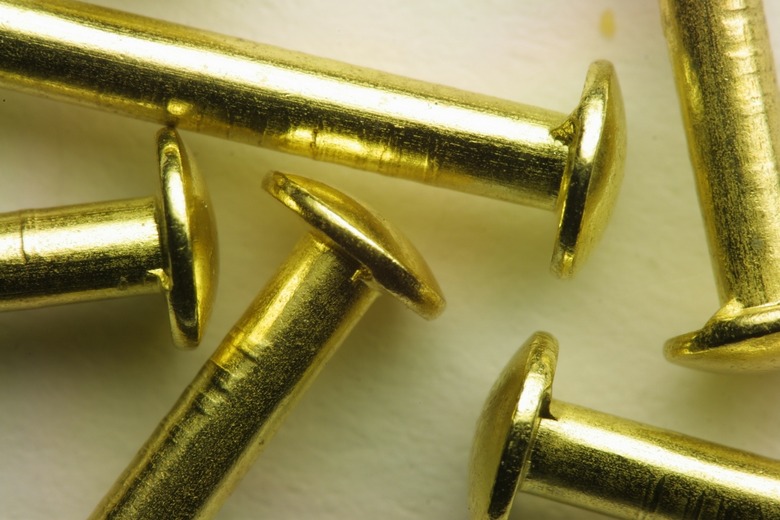3 Different Forms Of Brass
Brass is a metal alloy that generally has a bright golden sheen. It is used for musical instruments such as trumpets and saxophones, household bathroom fixtures, doorknobs, machine parts and even plumbing. There are three different major types of brass, and depending on which metals are in it, there can be different colors of brass.
TL;DR (Too Long; Didn't Read)
Brass is a metal alloy that generally has a bright golden sheen. All told, there are over 60 types of brasses. These are broken down into three families of brass: copper-zinc brasses, tin brasses and leaded brasses.
What Is Brass?
What Is Brass?
Brass is an alloy. So what is an alloy? An alloy is a mixture of two or more elements, one of which is always a metal. An alloy list, aside from brass, includes bronze, stainless steel and sterling silver.
In the case of brass, the alloy is made from copper and zinc, in addition to other materials.
Brass has been used throughout recorded history, going back as far as at least the fifth millennium BCE in China, and later in areas around the Aegean and the ancient Middle East. In the Roman Empire, coins were often made from brass.
Three Forms of Brass
Three Forms of Brass
All told, there are over 60 types of brasses. These are broken down into three families of brass. The three main families of brass are copper-zinc brasses, tin brasses and leaded brasses.
Copper zinc brasses contain a mixture of copper (Cu) and zinc (Zn). Tin brasses are made from copper (Cu), zinc (Zn) and tin (Sn). Leaded brasses are comprised of copper (Cu), zinc (Zn) and lead (Pb).
Further types of brasses include alpha brass, beta brass and alpha-beta brass. Alpha brass contains less than 37% zinc as part of the alloy. These brasses are often used in manufacturing machine parts. Beta brasses contain over 45% zinc and are only worked while hot. They are not as ductile as other brasses, but they are highly durable for structures.
Alpha-beta brasses (duplex brasses) are comprised of a range between 37% to 45% zinc. Alpha-beta brasses are commonly used for hinges, valves, fittings and gas appliances. They are hard but not very ductile in cold temperatures.
Different Colors of Brass
Different Colors of Brass
While brass brings to mind a bright gold metal, it actually comes in different colors. Other colorful types of brasses may be yellow, red, brown, silver or gold.
Different colors of brass occur depending on what other elements have been combined in the alloy mix for brass. For example, if manganese is added, it results in a rich brown hue, while the addition of nickel makes a bright silver brass.
Properties of Brass
Properties of Brass
The high luster and bright color of brass have long made it an attractive metal. But it is also easily worked, and it does not spark. That makes it safer for combustible environments.
Brass conducts heat well, so it is often used in anything involving heat exchange, like in radiators. It is much less conductive of electricity than pure copper, however. Brass retains its hardness without becoming brittle in cold temperatures. An attractive and economical feature of brass is its ability to be recycled. This is true for all grades of brass.
Brass is considered hygienic. This means it possesses antimicrobial properties and kills microorganisms after hours of contact with the alloy. This makes it a popular component for water pipes.
Brass is also highly resistant to corrosion, with some notable exceptions. Adding arsenic to brass helps with corrosion resistance. Brass can undergo a process called dezincification, which happens when zinc is lost from the alloy, and only copper remains. While this mainly changes the color of brass, in severe cases, it can weaken the metal. To preserve brass, take care to avoid exposure to chloride ions, such as in seawater. Cleaning solutions can dezincify brass as well.
Alloy List
Alloy List
The most common alloys used today are brass, bronze and stainless steel.
Bronze is made from copper and tin as well as different metals in smaller amounts. Bronze and brass are often grouped based on whether their copper dissolves other elements. When the copper does this, these alloys are called solid solution alloys.
Stainless steel is made from iron, which might be combined with any number of other metals to provide different strengths or corrosion resistance. Such metals include nickel, manganese and chromium. Stainless steel is popular for its lack of corrosion.
When alloys like brass, bronze or stainless steel contain lead, they are considered qualified alloys.
References
- Copper Development Association: Brasses
- United States Environmental Protection Agency: The Qualified Alloys: Stainless Steel, Brass, and Bronze Alloys that Contain Lead
- Metals4U: What is Brass? An In-depth Technical Guide
- Government of Canada, Canadian Conservation Institute: Preventing and Treating the Dezincification of Brass – Canadian Conservation Institute (CCI) Notes 9/13
Cite This Article
MLA
Hermance, Dianne. "3 Different Forms Of Brass" sciencing.com, https://www.sciencing.com/3-different-forms-brass-12123734/. 2 November 2021.
APA
Hermance, Dianne. (2021, November 2). 3 Different Forms Of Brass. sciencing.com. Retrieved from https://www.sciencing.com/3-different-forms-brass-12123734/
Chicago
Hermance, Dianne. 3 Different Forms Of Brass last modified March 24, 2022. https://www.sciencing.com/3-different-forms-brass-12123734/
